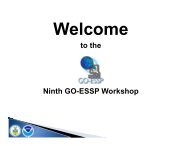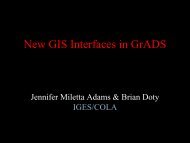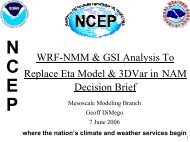The NCEP Climate Forecast System Reanalysis - NOAA National ...
The NCEP Climate Forecast System Reanalysis - NOAA National ...
The NCEP Climate Forecast System Reanalysis - NOAA National ...
You also want an ePaper? Increase the reach of your titles
YUMPU automatically turns print PDFs into web optimized ePapers that Google loves.
complete Reforecast dataset was created over the period 1981-present to calibrate the realtime operational forecasts. <strong>The</strong> initial states for this Reforecast effort were taken from R2for the atmosphere and land, and from the Global Ocean Data Assimilation <strong>System</strong>(GODAS, forced by fluxes from R2) for the ocean. This relatively quick effort wouldhave been inconceivable without R2 being available.Since the operational CFS v1 implementation in 2004 (Saha et al. 2006), CPC and manyother users have utilized the four times daily seasonal integrations for their monthly andseasonal forecast products. However, the system has many internal inconsistencies. Forinstance, the R2 atmospheric initial states are made with technology from the 1990s,while the atmospheric model component of CFS is from a decade later. Thus the initialstates and forecast model are inconsistent; a situation which leads to loss of skill duringthe early part of the integrations. One of the major goals of executing the new CFSR wasto create initial states for the atmosphere, ocean, land and sea-ice which are both state-ofthe-art,and as consistent as possible with the next version of the CFS v2 which is to beimplemented operationally at <strong>NCEP</strong> in 2010. Given the pace of model and dataassimilation development, such a reanalysis will be needed roughly every 5-10 years.We have now completed the CFSR for the 31-year period 1979-2009. It took almost twoyears to accomplish this feat. <strong>The</strong> primary novelties of this latest reanalysis are a)coupling to the ocean during the generation of the 6 hour guess field, b) an interactivesea-ice model, and c) assimilation of satellite radiances for the entire period. In addition,the much higher horizontal and vertical resolution (T382L64) of the atmosphere, modeland assimilation improvements over the last 10-15 years, and the use of prescribed CO 2concentrations as a function of time, should make for substantial improvements over R1and R2 (which were at T62L28 resolution). Another major advance was the real timemonitoring that took place during the execution of the CFSR. Thousands of graphicalplots were generated automatically at the end of each reanalyzed month, and displayed onthe CFSR website in real time. Many scientists from both CPC and EMC monitoreddifferent aspects of the reanalysis during this 2 year process. <strong>The</strong>re were many times that- 7 -





